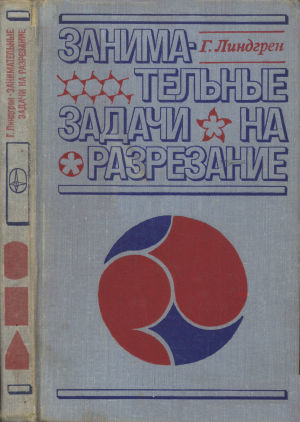

When I searched Worldcat for the title Recreational Problems in Geometric Dissections & How to Solve Them, I discovered that there had been a translation of my revised version of Harry Lindgren's book. The Russian title is Занимательные задачи на разрезание. (Its transliteration is Zanimatel'nye zadachi na razrezanie, and its translation is Entertaining Tasks for Cutting.) The book was translated by Yu. N. Sudarev (Ю. Н. Сударев) and was edited by Isaak Moiseevich Yaglom (И. М. Яглом), a Soviet mathematician and author of popular mathematics books, who also wrote an afterword.
The book was published in Moscow by Mir (Мир) in 1977. I was not listed in the Russian edition as the original reviser, although I was credited in the appendix that contains my original material. The contents differ somewhat from the English edition: The Russian edition does not include the two prefaces. What was originally a postscript seems to have become the conclusion.
The main illustration on the cover is copied from Figure 23.11, which in turn Lindgren had credited to Henry E. Dudeney, who gave it in Amusements in Mathematics as the solution to puzzle 160, as shown on page 175 of that book. The much smaller dissection hidden within the title on the cover is a copy of Lindgren's dissection in Figure 23.5.
Taking a careful look at the appearance of the 1977 Russian edition, I noticed that it wasn't as nicely designed as the Dover or the Van Nostrand editions. The paper in the Russian edition reminded me of the cheap paperback books in the USA in the 1950s and early 1960s: rough paper that slowly turned brown, whereas the paper in the Dover edition had a much smoother feel and a color that had faded more slowly from white to perhaps ivory. Each chapter in the 1972 edition started with a page that had a centered chapter number and a centered chapter title. Every other page in a chapter had a running head: with book title in the verso page and chapter title in the rechto page. These were left over from the 1964 original edition, which had been reproduced from the original.
The Russian translation was not entirely faithful to the 1972 revised edition. Gone is the preface to the revised edition, which you can read on my webpage for the book Recreational Problems in Geometric Dissections & How to Solve Them. I am rather disappointed with this decision, considering that it set the context for my Appendix H. At least Isaak Yaglom addressed in part that situation in the last paragraph of his afterword:(Yaglom's last paragraph:) "Автор книги неоднократно подчеркнвает, что развиваемая им теория (возможно, здесь правильнее было бы говорить не о "теории", а о "практике") отнюдь не исчерпывается только что прочитанным вами сочинением: уже само сравнение составленного Фредериксоном приложения VII с идущими от Линдгрена решениями показывает широкие возможности для личного творчества каждого. Навыки, развиваемые в процессе такого творчества, одинаково полезны как теоретику, так и практику; в отдельных случаях они могут открыть перед вами путь в науку. Итак, за работу, друзья!"(translated from the Russian with the assistance of Ms. Tatiana Kuznetsova:) "The author of the book repeatedly emphasizes that the theory he develops (perhaps it would be nicer to talk not about `theory' but about `practice') is by no means exhausted by the composition you just read: the very comparison of appendix VII created by Frederickson with the solutions coming from Lindgren shows great opportunities for the personal creativity of everyone. The skills developed in the process of such creativity are equally useful for both the theorist and the practitioner; in some cases they can open the way to science for you. So, let's get to work, friends!"I was sorry to see that the "Sources and Credits" section in the revised (1972) book had disappeared from the Russian version. I think that it is important to acknowledge the previous work of others. But I understand why it was left out, when most of those sources were unavailable to Russian readers due to rivalry engendered by the Cold War.
The Russian translator dropped a few dissections from among those in the revised edition. These included all of the dissections involving swastikas, namely Lindgren's Figures 9.13, 9.14, 9.15, 9.16, 13.6, and D24. (I sympathize with making those deletions, and actually I refused to include any swastikas in my books.) Also, Figures D14 and D35 were deleted, although I do not understand the motivation for those two deletions. Of course, when a dissection from Appendix D was deleted, the corresponding problem for solution in Appendix A was also deleted.
As with the other books in which I have had a hand, I wondered if the Russian version had been reviewed, and if so, what the reviewers thought. I consulted Prof. Robert S. Freeman, the Reference, Languages & Literatures Librarian of the Purdue University Libraries, on how I might find book reviews of this Russian-language book. He pointed me at a Russian periodical that referenced reviews of Russian books in a variety of different fields: Letopis' retsenzii, by Gosudarstvennaia tsentralnaia knizhnaia palata RSFSR. I searched for reviews in the years 1977-1981, but without success. If anyone can tell me where to find reviews of the Russian edition of Recreational Problems in Geometric Dissections & How to Solve Them, I would be most grateful!
Here is perhaps some insight into how this Russian translation was treated with respect to the translation of "gold standard" books authored by Henry E. Dudeney.
Citations in Russian sources.
Last updated January 22, 2018.